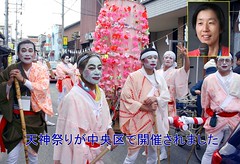Wednesday, September 23, 2009
Wide Show Mock-up
A mock-up of a Japanese Wide Show (current affairs and entertainment program) emphasising the features that demonstrate Nacalian theory of Japanese culture: that Japanese culture is predominantly visual or imago-centric.
The characteristics of Japanese current affairs programs that I want to emphasise are:
1) The faces of the commentators are seen displayed during the parts of the current affairs program that are filmed on location, so that viewers can SEE the expressions, and see the feelings that are being, or should be felt. (Yasuko's face, in the top right hand corner)
2) The Japanese is given subtitles so that the viewers can SEE what is being said.
American current affairs shows have a ticker tapish thing giving *additional* phono-lingistic information, and faces only when they are talking and often in side view.
However, like Japanese programs, American and Canadian shows often have canned laughter, which like the faces of the commentators in Japanese shows (1 above), lets the phono-centric Westerners know what should be felt via sound rather than vision.
Is there a Western version of the subtitles? David Letterman's late show also has occasional comments or narration from the band guy, Paul Schaffer. Hard boiled detective narrate what they are doing and thinking. But on Western current affairs shows is there extra phono-linguistic commentary on what is going on visually?
The characteristics of Japanese current affairs programs that I want to emphasise are:
1) The faces of the commentators are seen displayed during the parts of the current affairs program that are filmed on location, so that viewers can SEE the expressions, and see the feelings that are being, or should be felt. (Yasuko's face, in the top right hand corner)
2) The Japanese is given subtitles so that the viewers can SEE what is being said.
American current affairs shows have a ticker tapish thing giving *additional* phono-lingistic information, and faces only when they are talking and often in side view.
However, like Japanese programs, American and Canadian shows often have canned laughter, which like the faces of the commentators in Japanese shows (1 above), lets the phono-centric Westerners know what should be felt via sound rather than vision.
Is there a Western version of the subtitles? David Letterman's late show also has occasional comments or narration from the band guy, Paul Schaffer. Hard boiled detective narrate what they are doing and thinking. But on Western current affairs shows is there extra phono-linguistic commentary on what is going on visually?
Labels: culture, japan, japanese culture, logos, mirror, Nacalian, nihonbunka, specular, 日本文化
This blog represents the opinions of the author, Timothy Takemoto, and not the opinions of his employer.

